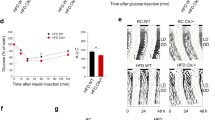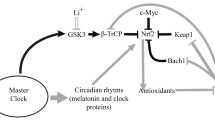Abstract
Resveratrol is a nutritional substance that has both metabolic and circadian effects. While some studies indicate a correlation between resveratrol and reduced gluconeogenesis, others propose the opposite. Our aim was to study the metabolic effect of resveratrol around the circadian clock in order to determine more accurately the hepatic signaling pathways involved. AML-12 hepatocytes were treated with resveratrol and clock and metabolic markers were measured around the clock. Resveratrol-treated AML-12 hepatocytes showed reduced ratio of the following key metabolic factors: phosphorylated PP2A to total PP2A (pPP2A/PP2A), pAKT/AKT, pFOXO1/FOXO1 and pAMPK/AMPK, indicating inhibition of AKT and AMPK, but activation of PP2A and FOXO1. In addition, the levels of phosphorylated mTOR were low after resveratrol treatment. The levels of the key gluconeogenic enzyme phosphoenolpyruvate carboxykinase (PEPCK) were significantly higher after resveratrol treatment. In accordance with the reduced mTOR activity, the ratio of pBMAL1/BMAL1, the clock transcription factor, also decreased. Bmal1 mRNA oscillated robustly in AML-12 hepatocytes, but resveratrol treatment led to a phase advance and a decrease in its amplitude, similarly to the effect on Srebp1c and Pgc1α mRNA. After resveratrol treatment, daily mRNA levels of Bmal1, Sirt1 and Srebp1c were significantly higher. Resveratrol changes the circadian expression of metabolic and clock genes activating the fasting state and inducing the PP2A-FOXO1-PEPCK pathway.




Similar content being viewed by others
Data Availability
The datasets generated during and/or analyzed during the current study are available from the corresponding author on reasonable request.
Abbreviations
- AKT:
-
Protein kinase B
- AMPK:
-
AMP-activated protein kinase
- Bmal1:
-
Brain and muscle Arnt-like protein-1
- cAMP:
-
Cyclic AMP
- Clock:
-
Circadian locomotor output cycles kaput
- Cry:
-
Cryptochrome
- PDE:
-
Phosphodiesterase
- PEPCK:
-
Phosphoenolpyruvate carboxykinase
- Per:
-
Period
- PKA:
-
Protein kinase A
- PP2A:
-
Protein phosphatase 2
- SCN:
-
Suprachiasmatic nuclei
- Sirt1:
-
Sirtuin 1
- SREBP1c:
-
Sterol regulatory element-binding protein 1c
References
Devlin PF (2002) Signs of the time: environmental input to the circadian clock. J Exp Bot 53:1535–1550
Richards J, Gumz ML (2012) Advances in understanding the peripheral circadian clocks. FASEB J 26:3602–3613
Froy O (2010) Metabolism and circadian rhythms--implications for obesity. Endocr Rev 31:1–24
Albrecht U (2012) Timing to perfection: the biology of central and peripheral circadian clocks. Neuron 74:246–260
Eckel-Mahan K, Sassone-Corsi P (2013) Metabolism and the circadian clock converge. Physiol Rev 93:107–135
Jakubowicz D, Barnea M, Wainstein J, Froy O (2013) High caloric intake at breakfast vs. dinner differentially influences weight loss of overweight and obese women. Obesity (Silver Spring) 21:2504–2512
Tsai HY, Ho CT, Chen YK (2017) Biological actions and molecular effects of resveratrol, pterostilbene, and 3′-hydroxypterostilbene. J Food Drug Anal 25:134–147. https://doi.org/10.1016/j.jfda.2016.07.004
Sarma A, Sharma VP, Sarkar AB, Sekar MC, Samuel K, Geusz ME (2016) The circadian clock modulates anti-cancer properties of curcumin. BMC Cancer 16:759
Okada Y, Okada M (2020) Quercetin, caffeic acid and resveratrol regulate circadian clock genes and aging-related genes in young and old human lung fibroblast cells. Mol Biol Rep 47:1021–1032
Belden WJ, Dunlap JC (2008) SIRT1 is a circadian deacetylase for core clock components. Cell 134:212–214
Ramirez-Garza SL, Laveriano-Santos EP, Marhuenda-Munoz M, Storniolo CE, Tresserra-Rimbau A, Vallverdu-Queralt A, Lamuela-Raventos RM (2018) Health effects of resveratrol: results from human intervention trials. Nutrients 10:1892
Mikstacka R, Rimando AM, Ignatowicz E (2010) Antioxidant effect of trans-resveratrol, pterostilbene, quercetin and their combinations in human erythrocytes in vitro. Plant Foods Hum Nutr 65:57–63
Sun X, Cao Z, Ma Y, Shao Y, Zhang J, Yuan G, Guo X (2021) Resveratrol attenuates dapagliflozin-induced renal gluconeogenesis via activating the PI3K/Akt pathway and suppressing the FoxO1 pathway in type 2 diabetes. Food Funct 12:1207–1218
Chen S, Li J, Zhang Z, Li W, Sun Y, Zhang Q, Feng X, Zhu W (2012) Effects of resveratrol on the amelioration of insulin resistance in KKAy mice. Can J Physiol Pharmacol 90:237–242
Park JM, Kim TH, Bae JS, Kim MY, Kim KS, Ahn YH (2010) Role of resveratrol in FOXO1-mediated gluconeogenic gene expression in the liver. Biochem Biophys Res Commun 403:329–334
Sherman H, Froy O (2008) Expression of human β-defensin 1 is regulated via c-myc and the biological clock. Mol Immunol 45:3163–3167
Park SJ, Ahmad F, Philp A, Baar K, Williams T, Luo H, Ke H, Rehmann H, Taussig R, Brown AL, Kim MK, Beaven MA, Burgin AB, Manganiello V, Chung JH (2012) Resveratrol ameliorates aging-related metabolic phenotypes by inhibiting cAMP phosphodiesterases. Cell 148:421–433
Ahn JH, McAvoy T, Rakhilin SV, Nishi A, Greengard P, Nairn AC (2007) Protein kinase a activates protein phosphatase 2A by phosphorylation of the B56delta subunit. Proc Natl Acad Sci USA 104:2979–2984
Leslie SN, Nairn AC (2019) cAMP regulation of protein phosphatases PP1 and PP2A in brain. Biochim Biophys Acta Mol Cell Res 1866:64–73
Feschenko MS, Stevenson E, Nairn AC, Sweadner KJ (2002) A novel cAMP-stimulated pathway in protein phosphatase 2A activation. J Pharmacol Exp Ther 302:111–118
Schweiger S, Matthes F, Posey K, Kickstein E, Weber S, Hettich MM, Pfurtscheller S, Ehninger D, Schneider R, Krauss S (2017) Resveratrol induces dephosphorylation of tau by interfering with the MID1-PP2A complex. Sci Rep 7:13753
Liu C, Zhang R, Sun C, Zhang H, Xu C, Liu W, Gao W, Huang S, Chen L (2015) Resveratrol prevents cadmium activation of Erk1/2 and JNK pathways from neuronal cell death via protein phosphatases 2A and 5. J Neurochem 135:466–478
Hong K, Lou L, Gupta S, Ribeiro-Neto F, Altschuler DL (2008) A novel Epac-rap-PP2A signaling module controls cAMP-dependent Akt regulation. J Biol Chem 283:23129–23138
Tohme R, Izadmehr S, Gandhe S, Tabaro G, Vallabhaneni S, Thomas A, Vasireddi N, Dhawan NS, Ma'ayan A, Sharma N, Galsky MD, Ohlmeyer M, Sangodkar J, Narla G (2019) Direct activation of PP2A for the treatment of tyrosine kinase inhibitor-resistant lung adenocarcinoma. JCI Insight 4:e125693
Tomobe K, Shinozuka T, Kawashima T, Kawashima-Ohya Y, Nomura Y (2013) Age-related changes of forkhead transcription factor FOXO1 in the liver of senescence-accelerated mouse SAMP8. Arch Gerontol Geriatr 57:417–422
Lipton JO, Yuan ED, Boyle LM, Ebrahimi-Fakhari D, Kwiatkowski E, Nathan A, Guttler T, Davis F, Asara JM, Sahin M (2015) The circadian protein BMAL1 regulates translation in response to S6K1-mediated phosphorylation. Cell 161:1138–1151
Joseph BK, Liu HY, Francisco J, Pandya D, Donigan M, Gallo-Ebert C, Giordano C, Bata A, Nickels JT Jr (2015) Inhibition of AMP kinase by the protein phosphatase 2A Heterotrimer, PP2APpp2r2d. J Biol Chem 290:10588–10598
Lan F, Weikel KA, Cacicedo JM, Ido Y (2017) Resveratrol-induced AMP-activated protein kinase activation is cell-type dependent: lessons from basic research for clinical application. Nutrients 9:751
Genzer Y, Dadon M, Burg C, Chapnik N, Froy O (2015) Ketogenic diet delays the phase of circadian rhythms and does not affect AMP-activated protein kinase (AMPK) in mouse liver. Mol Cell Endocrinol 417:124–130
Foretz M, Ancellin N, Andreelli F, Saintillan Y, Grondin P, Kahn A, Thorens B, Vaulont S, Viollet B (2005) Short-term overexpression of a constitutively active form of AMP-activated protein kinase in the liver leads to mild hypoglycemia and fatty liver. Diabetes 54:1331–1339
Dadon-Freiberg M, Chapnik N, Froy O (2020) REV-ERBalpha activates the mTOR signalling pathway and promotes myotubes differentiation. Biol Cell 112:213–221
Lee Y, Kim EK (2013) AMP-activated protein kinase as a key molecular link between metabolism and clockwork. Exp Mol Med 45:e33
Froy O, Garaulet M (2018) The circadian clock in white and brown adipose tissue: mechanistic, endocrine, and clinical aspects. Endocr Rev 39:261–273
Oike H (2017) Modulation of circadian clocks by nutrients and food factors. Biosci Biotechnol Biochem 81:863–870
Chung JH, Manganiello V, Dyck JR (2012) Resveratrol as a calorie restriction mimetic: therapeutic implications. Trends Cell Biol 22:546–554
Author information
Authors and Affiliations
Contributions
O.C. and N.C. performed the experiments, cell collection and analyses. O.F. provided critical analyses of the data. O.C. wrote the first draft of the manuscript. O.F. extensively revised the manuscript.
Corresponding author
Ethics declarations
Conflict of Interest
Authors declare no conflict of interest.
Additional information
Publisher’s Note
Springer Nature remains neutral with regard to jurisdictional claims in published maps and institutional affiliations.
Supplementary Information
ESM 1
(DOCX 12 kb)
Rights and permissions
About this article
Cite this article
Chatam, O., Chapnik, N. & Froy, O. Resveratrol Induces the Fasting State and Alters Circadian Metabolism in Hepatocytes. Plant Foods Hum Nutr 77, 128–134 (2022). https://doi.org/10.1007/s11130-022-00954-7
Accepted:
Published:
Issue Date:
DOI: https://doi.org/10.1007/s11130-022-00954-7




